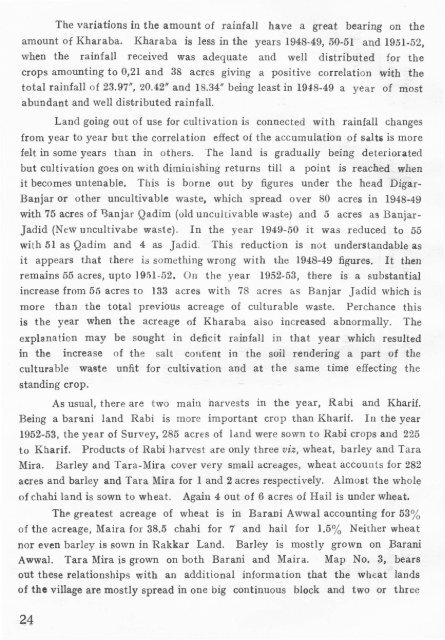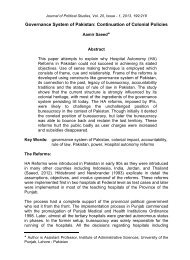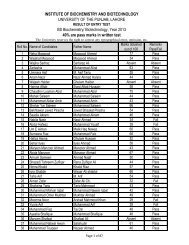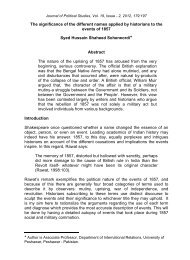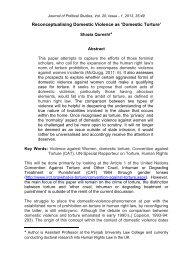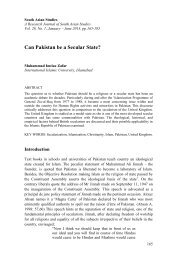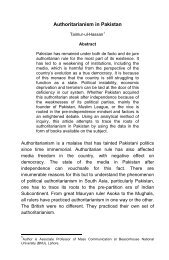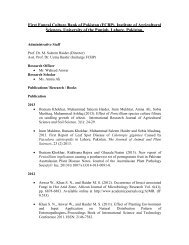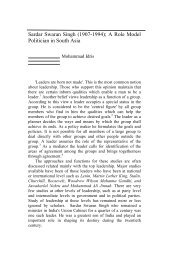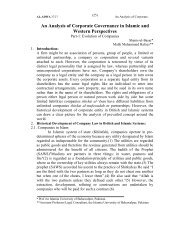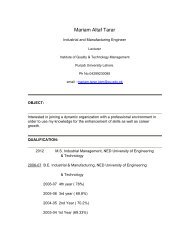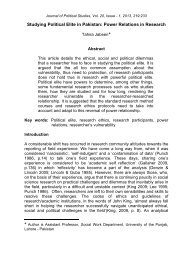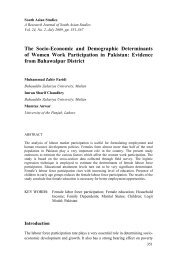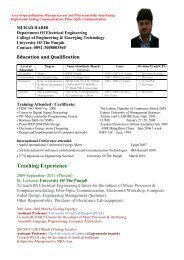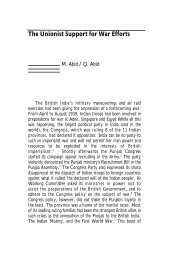pakistan geographical review 1954 - University of the Punjab
pakistan geographical review 1954 - University of the Punjab
pakistan geographical review 1954 - University of the Punjab
You also want an ePaper? Increase the reach of your titles
YUMPU automatically turns print PDFs into web optimized ePapers that Google loves.
The variations in <strong>the</strong> amount <strong>of</strong> rainfall have a great bearing on <strong>the</strong><br />
amount <strong>of</strong> Kharaba. Kharaba is less in <strong>the</strong> years 1948-49, 50-51 and 1951-52,<br />
when <strong>the</strong> rainfall received was adequate and well distributed for <strong>the</strong><br />
crops amounting to 0,21 and 38 acres giving a positive correlation with <strong>the</strong><br />
total rainfall <strong>of</strong> 23.971/, 20.421/and 18.341/being least in 1948-49 a year <strong>of</strong> most<br />
abundant and well distributed rainfall.<br />
Land going out <strong>of</strong> use for cultivation is connected with rainfall changes<br />
from year to year but <strong>the</strong> correlation effect <strong>of</strong> <strong>the</strong> accumulation <strong>of</strong> salts is more<br />
felt in some years than in o<strong>the</strong>rs. The land is gradually being deteriorated<br />
but cultivation goes on with diminishing returns till a point is reached when<br />
it becomes untenable. This is borne out by figures under <strong>the</strong> head Digar-<br />
Banjar or o<strong>the</strong>r uncultivable waste, which spread over 80 acres in 1948-49<br />
with 75 acres <strong>of</strong> Banjar Qadim (old uncultivable waste) and 5 acres as Banjar-<br />
Jadid (New uncultivabe waste). In <strong>the</strong> year 1949-50 it was reduced to 55<br />
with 51 as Qadim and 4 as Jadid. This reduction is not understandable as<br />
it appears that <strong>the</strong>re is something wrong with <strong>the</strong> 1948-49 figures. It <strong>the</strong>n<br />
remains 55 acres, upto ]91>1-52. On <strong>the</strong> year 1952-53, <strong>the</strong>re is a substantial<br />
increase from 55 acres to 133 acres with 78 acres as Banjar J adid which is<br />
more than <strong>the</strong> total previous acreage <strong>of</strong> culturable waste. Perchance this<br />
is <strong>the</strong> year when <strong>the</strong> acreage <strong>of</strong> Kharaba also increased abnormally. The<br />
explanation may be sought in deficit rainfall in that year which resulted<br />
in <strong>the</strong> increase <strong>of</strong> <strong>the</strong> salt content in <strong>the</strong> soil rendering a part <strong>of</strong> <strong>the</strong><br />
culturable waste unfit for cultivation and at <strong>the</strong> same time effecting <strong>the</strong><br />
standing crop.<br />
As usual, <strong>the</strong>re are two main harvests in <strong>the</strong> year, Rabi and Kharif.<br />
Being a bar-ani land Rabi is more important crop than Kharif. In <strong>the</strong> year<br />
1952-53, <strong>the</strong> year <strong>of</strong> Survey, 285 acres <strong>of</strong> land were sown to Rabi crops and 225<br />
to Kharif. Products <strong>of</strong> Rabi harvest are only three viz, wheat, barley and Tara<br />
Mira. Barley and Tara-Mira cover very small acreages, wheat accounts for 282<br />
acres and barley and Tara Mira for 1 and 2 acres respectively. Almost <strong>the</strong> whole<br />
<strong>of</strong> chahi land is sown to wheat. Again 4 out <strong>of</strong> 6 acres <strong>of</strong> Hail is under wheat.<br />
ThE'!greatest acreage <strong>of</strong> wheat is in Barani Awwal accounting for 53%<br />
<strong>of</strong> <strong>the</strong> acreage, Maira for 38.5 chahi for 7 and hail for 1.5% Nei<strong>the</strong>r wheat<br />
nor even barley is sown in Rakkar Land. Barley is mostly grown on Barani<br />
Awwal. Tara Mira is grown on both Barani and Mair a. Map No.3, bears<br />
out <strong>the</strong>se relationships with an additional information that <strong>the</strong> wheat lands<br />
<strong>of</strong> <strong>the</strong> village are mostly spread in one big continuous block and two or three<br />
24


